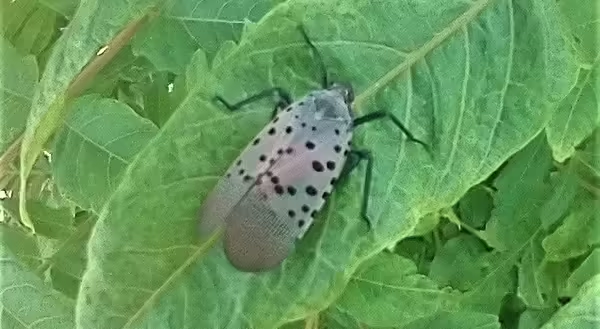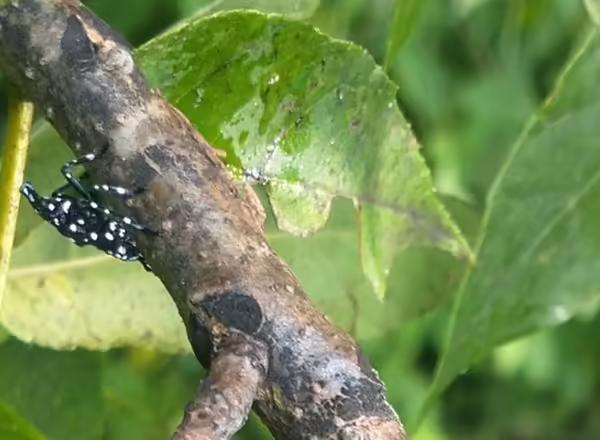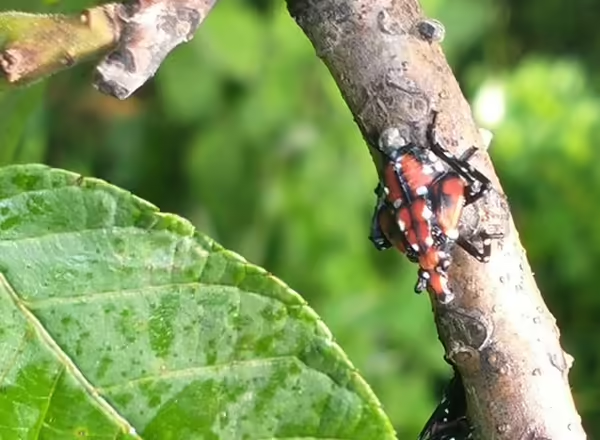
In a summer when many feel like they have been ambushed by cicadas, it’s easy to forget that the spotted lanternfly (Lycorma delicatula) has made its way into our state. Infestation status has been established in Cook County with no sightings documented yet in the rest of the state. The threat of its range expanding to other counties is elevated, as the spotted lanternfly has an affinity to cars, trucks and trains. This has allowed the insect to spread to 18 states since being first discovered in 2014 in Pennsylvania (Current Distribution). In Cook County, populations are still relatively low, but the spotted lanternfly has the potential to increase in population size similar to the densities seen in this year’s Cicadaggedon. Beyond being a nuisance pest, it is a pest in grapes, tree fruit, trees, and woody ornamentals, by using its piercing sucking mouthparts to feed on the sap of these plants. They also produce high amounts of waste in the form of honeydew, which encourages the growth of sooty mold. (Right: adult spotted lanternfly on tree-of-heaven)
With the growing concern over this pest, it is important to understand how to best react when finding this insect. Proper identification is crucial in recognizing infestations. Use the fact sheet published by Illinois Extension to best determine the presence of spotted lanternfly. Sightings of spotted lanternfly should be reported with a picture to lanternfly@illinois.edu.
Once properly identified, control efforts can begin. Populations are currently low enough that mechanical methods are the suggested route of control by the Illinois Department of Agriculture. Whenever possible, nymph and adult stages of spotted lanternfly should be crushed upon sight. Spotted lanternfly eggs, which can be found on hard surfaces, should be scraped off and destroyed when identified.
Preventative control options are limited, but there are some measures that can be taken to lower the ability of spotted lanternfly becoming established. One option for preventing spotted lanternfly infestations is through the elimination of one of its favorite hosts, the invasive tree-of-heaven (Ailanthus altissima). Seedlings can be removed through pulling, while mature trees must be killed through the use of herbicides. Cutting down mature tree-of-heaven can result in root suckling and resprouting, which makes it a poor form of control for the tree. For more information, see the article, Tree-of-heaven.


The use of insecticides against the spotted lanternfly in Illinois may not always be the advisable option. Populations of this invasive species are still low enough where insecticide treatments may have a greater detrimental effect in beneficial insect populations compared to their ability to control spotted lanternfly. Management with insecticides should be reserved for situations where the spotted lanternfly is in high densities. If chemical control is necessary, spotted lanternfly is highly susceptible to most chemical insecticides, allowing low toxic products such as insecticidal oils and soaps to be effective. Contact insecticides with low residual effects may be the best option for those wanting to control spotted lanternfly chemically, as they reduce the effects on non-target species and allow for quick control. Insecticides should be rotated to provide the best long-term results against spotted lanternfly and prevent resistance. Check out this guide by Penn State Extension for more about insecticides and always read and follow the label to apply pesticides legally and safely. Currently, there are very few insecticides labeled for spotted lanternfly within the state of Illinois, so make sure to check labels for both spotted lanternfly and treatment site before purchasing. The number of insecticides registered for use against the spotted lanternfly in the state of Illinois may increase under FIFRA’s 24(c) registration allowance to meet local needs.
The state and county responses to spotted lanternfly are subject to change so please keep checking with University of Illinois Extension and the Illinois Department of Agriculture for updates.
Photo (at very top) of adult spotted lanternfly on tree-of-heaven, photo (near top) of first-third instar nymph (black), and photo (near bottom) of fourth-fifth instar nymph (red) - all taken by John Schepis in Winchester VA.
ABOUT THE AUTHOR: John Schepis provides subject matter expertise and training in pesticide safety with an emphasis on entomology.